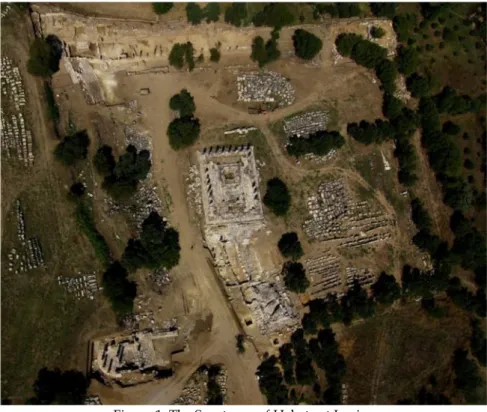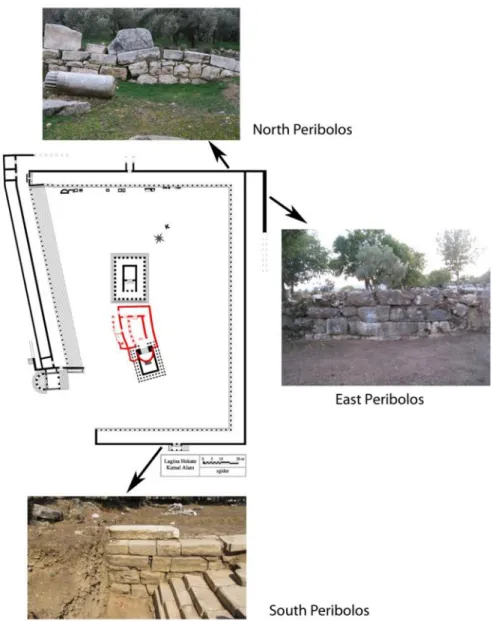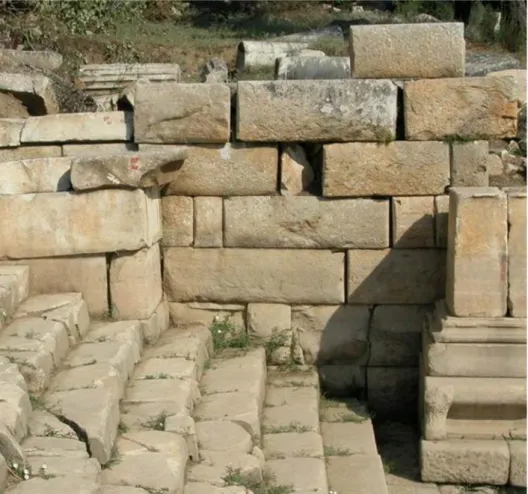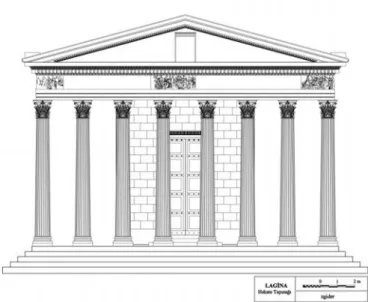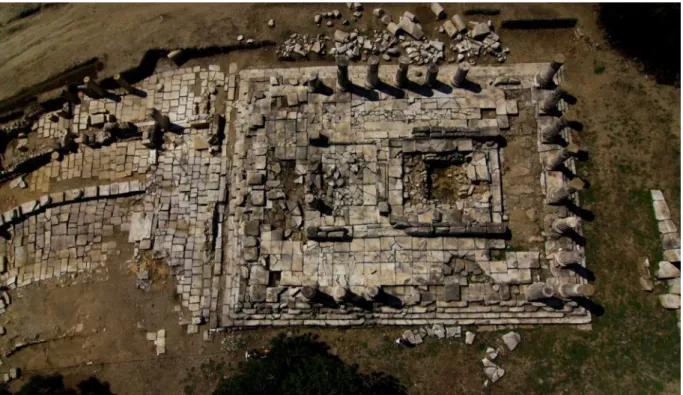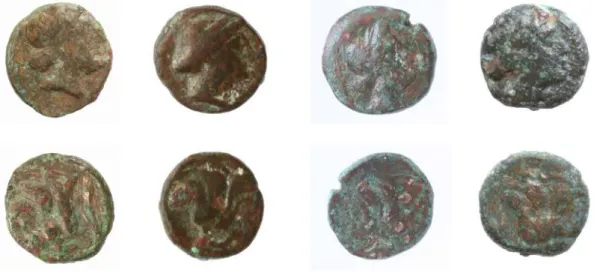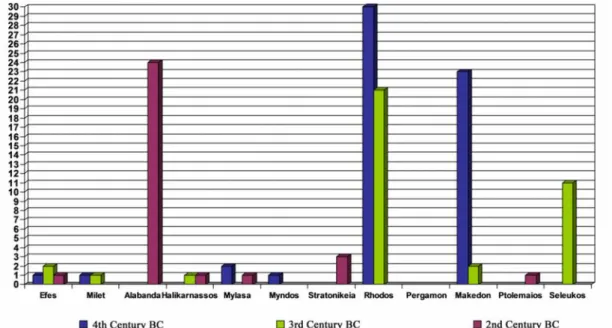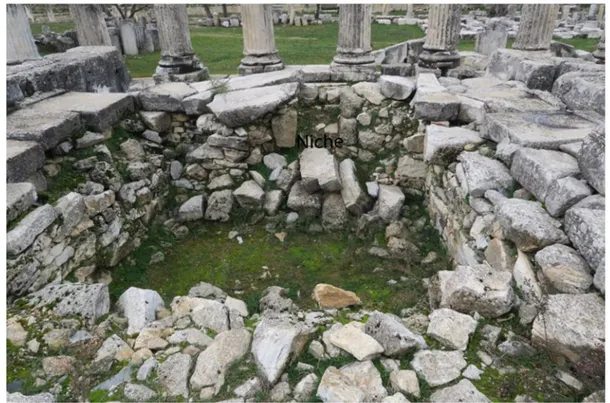The Journal of Anatolian Archaeological Studies
Volume 1 (2018)
The Sanctuary of Hekate at Lagina in the 4th Century BC
MÖ 4. yy’da Lagina Hekate Kutsal Alanı
Geliş Tarihi: 14.07.2018 | Kabul Tarihi: 07.10.2018 | Online Yayın Tarihi: 15.11.2018
Makale Künyesi: A. Büyüközer, “The Sanctuary of Hekate at Lagina in the 4th
Century BC”, Arkhaia Anatolika 1 (2018), 15-30. DOI: 10.32949/Arkhaia.2018.1
Arkhaia Anatolika, Anadolu Arkeolojisi Araştırmaları Dergisi “Açık Erişimli” (Open Access) bir
dergidir. Kullanıcılar, dergide yayınlanan makalelerin tamamını tam metin olarak okuyabilir, indirebilir, makalelerin çıktısını alabilir ve kaynak göstermek suretiyle bilimsel çalışmalarında bu makalelerden faydalanabilir. Bunun için yayıncıdan ve yazar(lar)dan izin almasına gerek yoktur. Dergide yayınlanan makalelerin bilimsel ve hukuki sorumluluğu tamamen yazar(lar)ına aittir.
Arkhaia Anatolika, The Journal of Anatolian Archaeological Studies follows Open Access as a
publishing model. This model provides immediate, worldwide, barrier-free access to the full text of research articles without requiring a subscription to the articles published in this journal. Published material is freely available to all interested online readers.
The scientific and legal propriety of the articles published in the journal belongs exclusively to the author(s).
The Sanctuary of Hekate at Lagina in the 4th Century BC
MÖ 4. yy’da Lagina Hekate Kutsal Alanı
Aytekin BÜYÜKÖZER
Abstract
The Lagina Hekate Sanctuary was finalized with reconstruction activities in the Late Hellenistic and Early Imperial period. The four sides of the sanctuary were surrounded by stoas in the Doric style built during the Early Imperial period. At a point near the center is the temple and there is an altar located south-east of the temple. As a result of ongoing work in the sacred precinct, the evidence shows that the Temple and cult of Hekate dated back to the 4th century BC. The aim of this study is to determine how old the sanctuary and cult of Hekate in Lagina is based on the archaeological and epigraphical data.
The peribolos, which were found in the northeastern part of the sanctuary and were later discovered to have surrounded four sides of the sanctuary, are architecturally the most important proof that they date back to the 4th century BC. The walls are flat-edged, with a pulvinated surface and built as a double row of pitch-faced stones and rectangular blocks. This masonry technique is also found in Stratonikeia Lower City Walls, the repair phases in Kadıkulesi Hill on the western and northern walls and it has been dated back to the 4th century BC. In the context of Maussolos’ urbanization policy, construction activities have also been carried out in Lagina besides Stratonikeia. The data obtained from the naos of the altar have reinforced the opinion that there was a cult building there; especially the numerous coins dated to the 4th and 3rd centuries, the terracotta figurines dated to the Hellenistic period are the other archeological evidence showing that there was a cult building before the temple with Corinthian peristasis. Numerous inscriptions have been found in the sanctuary and most of the inscriptions have been dated to the Roman Imperial period. Three of the inscriptions on the sacred area have been dated to the 4th century BC and one of them has been dated to 197-166 BC. The contents of these inscriptions clearly demonstrate the presence of a sanctuary here and clearly proves that this area was devoted to Hekate. The fact that Stratonikeia was called Hekatesia (the city of Hekate) from 430 to 280 BC is another indication of the importance of Hekate in the region. The Hekate Cult must have already been very powerful in the 4th and 3rd centuries BC so that a magnificent temple could be built with Corinthian peristasis at the end of the 2nd century BC.
Key Words: Lagina, Hekate, Sanctuary, Peribolos, Clasical period, Temple Özet
Lagina Hekate Kutsal Alanı Geç Hellenistik ve Erken İmparatorluk dönemlerindeki imar faaliyetleri ile son şeklini almıştır. Kutsal alanın dört tarafı Erken İmparatorluk Dönemi’nde inşa edilen Dor düzenindeki stoalarla çevrelenmiştir. Merkeze yakın bir noktada tapınak, tapınağın güneydoğusunda ise altar yer almaktadır. Buna karşın kutsal alanda halen devam eden çalışmalar sonucunda Hekate Tapınağı
Assoc. Prof. Dr. Aytekin Büyüközer, Selcuk University, Faculty of Literature, Department of Archaeology,
Konya/Turkey.
ve kültünün en azından MÖ 4. yy’a kadar gittiğini kanıtlayan verileri ulaşılmıştır. Bu çalışmanın amacı, kutsal alanın ve Hekate kültünün, arkeolojik ve epigrafik verilerden hareketle Lagina’da ne kadar eskiye gittiğini belirlemektedir. Bu kapsamda ilk olarak kutsal alanın kuzeydoğusunda tespit edilip daha sonra kutsal alanın dört bir tarafını çevrelediği anlaşılan peribolos mimari olarak kutsal alanın MÖ 4. yy’a kadar uzandığını gösteren en önemli kanıttır. Duvar, düz kenarlı, kabarık yüzeye sahip kaba yonulu dörtgen ve yamuk bloklardan çift sıra örgülü inşa edilmiştir. Bu örgü tekniği Stratonikeia Aşağı Kent Surları’nda, Kadıkulesi Tepesi’ndeki tamirat evrelerinde, batı ve kuzey surlarında da tespit edilmiş ve MÖ 4. yy’a tarihlendirilmiştir. Maussolos’un şehirleşme politikası çerçevesinde Stratonikeia’nın yanı sıra Lagina’da da imar faaliyetleri gerçekleşmiştir. Tapınak naosunda elde edilen veriler ise burada bir kült yapısı olduğu düşüncesini iyice pekiştirmiştir. Özellikle MÖ 4. ve 3. yy’a tarihlendirilen sikkelerin yoğunluğu, Hellenistik Dönem’e tarihlendirilen terrakota figürinler ve çok sayıda faltaşı burada korinth peristasisli yapıdan önce bir kült yapısını gösteren diğer arkeolojik kanıtlardır. Kutsal alanda çok sayıda yazıt bulunmuş ve yazıtların büyük kısmı Roma İmparatorluk Dönemi’ne tarihlendirilmiştir. Bununla birlikte kutsal alanda bulunan yazıtlardan üçünün MÖ 4. yy’a, birinin MÖ 197-166 yıllarına ait olduğu tespit edilmiştir. Bu yazıtların içerikleri burada bir kutsal alanının varlığını, bu alanın da Hekate’ye adandığını açıkça kanıtlar. Stratonikeia’nın isminin MÖ 430’dan 280’e kadar Hekatesia (Hekate’nin şehri) ismini alması da bölgede Hekate kültünün ne denli önemli olduğunun bir başka göstergesidir. Zaten Hekate Kültü MÖ 4 ve 3. yy’da çok güçlü olmalı ki MÖ 2. yy’ın sonunda korinth peristasisli görkemli tapınak yapılabilsin.
Anahtar Kelimeler: Lagina, Hekate, Kutsal Alan, Peribolos, Klasik Dönem, Tapınak Introduction
The Lagina Hekate Sanctuary was one of the sacred areas of Stratonikeia in Karia District and it was connected to this town by a stone-paved road of about 9 km in length1. Lagina is located about 1 km north-east of Turgut in the province of Muğla. Since the area where the remnants were found was in the south-west of the sanctuary and the propylon’s in
situ in the protected passage part used as the ceremonial gate, it is called "Kapıtaş Mevkii" by
the local people of the region.
The buildings in Lagina show that the sanctuary was shaped within the frame of the constructions activities in the Late Hellenistic and Early Imperial eras. The temple, the most important building of the sanctuary, has been dated back to the end of the 2nd century and the beginning of the 1st century BC2, altar3, propylon4, which was used as a ceremonial gate, South Propylon5, stoas6that surround the sanctuary and naiskoi7have been dated to the Early Imperial period. On the other hand, there are some suggestions that the sanctuary and the temple could date back to an even earlier period, in until the Late Classical period8. In terms of ornamental scheme and detail forms, F. Rumscheid dates antae bases and antae capitals to 300 BC9. On the other hand, P. Pedersen, on the basis of the Karian-Ionian lewis holes in the form of a “wolf mouth” seen in a few architectural blocks around the temple, tries to support Rumscheid’s proposal from a different perspective stating that there may be an earlier building here10. The work carried out in the sacred area supports these claims with
1Another sanctuary of Stratonikeia is the Sanctuary of Zeus at Panamara (Hanslik-Andree 1949, 450-456; Bean
1987, 112-114).
2Tırpan et al. 2012, 181-202. 3Tırpan – Söğüt 2005, 17-24.
4Tırpan 1996, 211-213, fig. 1-4; Tırpan 1997, 309-313, fig. 1-10; Tırpan 1998, 173-194; Ortaç 2001, 29-32; Tırpan –
Söğüt 2005, 5-12.
5Büyüközer 2015, 80-81.
6Gider 2005, 39-69; Gider 2012, 263-280; Gider-Büyüközer 2013, 651-674. 7Söğüt 2008, 421-431; Söğüt 2011, 294-302.
8Tırpan et al. 2012, 196-197. 9Rumscheid 1994, 138-139. 10Pedersen 2012, 513-525.
archaeological evidence. In this study, the evaluation will be made on the data obtained from the research carried out on peribolos, inscriptions and the naos of the temple11.
Peribolos
The Lagina Hekate Sanctuary was finalized by the zoning activities carried out in the Early Imperial period (fig. 1-2). According to this regulation, the outer walls of the stoas surrounding the four sides of the sacred area also functioned as a peribolos.However, the wall on the northeast corner of the sanctuary, located 11,5 m east of the border in the Early Imperial period, is giving hints about an arrangement that dates back to an older period based on both block dimensions and masonry technique (fig. 2). The walls are flat-edged, with a pulvinated surface and built as a double row of pitch-faced stones and rectangular blocks. In 2009 in the north of the sanctuary12(fig. 2), in 2011, in the west and south (fig. 2) of the sanctuary, excavations were carried out to determine the temenos borders. From this work, it was determined that the wall in the northeast also continued in the west, north and south. This situation has revealed that the wall in the northeast is actually a peribolos that surrounds the four corners of the sacred area. The masonry technique seen in the mentioned walls has also been detected in the Stratonikeia Lower City Walls, repair phases in Kadıkulesi Hill13, the western and northern walls14. These walls in the city were dated to the 4th century BC and it was understood that a large-scale development activity was carried out in the city during the Hekatomnid Dynasty15. The peribolos, which resembles the walls of Stratonikeia, apparently built as a result of Mausolos’ urbanization policy, was built in the framework of the same zoning activities and that perhaps the existing cult area was turned into an introverted area. Although there is no building dated to the 4th century BC in the sacred area, these walls prove the existence of an area for Hekate cult at least since the Late Classical period.
Figure 1: The Sanctuary of Hekate at Lagina
11I am grateful to Ahmet A. Tırpan and Bilal Söğüt for permission to study the material discussed in this article. 12Tırpan – Gider 2011, 381, fig. 10.
13Söğüt 2013, 609. 14Söğüt 2013, 609, 3-4. 15Söğüt 2013, 609-610.
Figure 2: Peribolos in 4th century BC.
Research conducted in the north, south, and west of the sanctuary have revealed that some changes were made to the peribolos of the sanctuary during the Hellenistic period when the temple was built. The West Stoa’s south border was made of an arched bossage wall dated to the 2nd century BC16 (fig. 3). This wall continues to the north from the west of the
stoa. Walls with the same masonry technique have been detected both in the northwest
corner and in the south of the sanctuary. This situation reveals that some alterations were made in the peribolos beside the construction of the temple in the 2nd century BC. According to all this data the sanctuary, the borders of which were established in the 4th century BC, took its final shape as a result of three reconstruction activities in the Hellenistic period and then in the Early Imperial period. It is understood that the boundaries of the sacred sites created in the Classical period were partially shrunk apart from the southern part of the sanctuary with reconstruction activities during the Hellenistic and Early Imperial periods.
16Similar examples have been dated to the Hellenistic period. The building called "St. Paul Prison" at Ephesus
(Winter 1994, 38-39; Karlsson 1994, 144-146, fig. 1), The walls dating to the Hellenistic period of the Miletos Theater (Karlsson 1994, 147, fig. 4), City walls of Herakleia (Latmos) (Krischen 1922; Winter 1994, 37-38; McNicoll 1997, 75-81; Karlsson 1994, fig. 5), “Round Tower 1” located in the Knidos Military Harbor’s defense line (McNicoll 1997, 59, fn. 78) is similar to the wall mentioned.
Figure 3: Hellenistic wall of West Stoa’s south border Temple17
The Lagina Hekate Temple was built approximately in the middle of the sanctuary, in the direction of northwest-southeast. The temple stands on a five-stepped crepidoma. The foundation of the temple was created by smoothing natural bedrock in some places, the remaining areas were supported by properly cut conglomerate stones and the level of the
stylobate was adjusted. The Hekate Temple is a temple with 8 x 11 columns and pseudo-dipteral plan type18 (fig. 4). The temple, whose entrance is located on the southwest facade, is composed of a deep pronaos and a naos with an almost square plan. It has no opisthodomos. There is a level difference of 0,60 m between the pronaos and the naos. The peristasis columns of the temple have Attic-Ionic bases and Corinthian capitals (fig. 5). The in-antis columns are with Asiatic bases and Ionic capitals. There are some questions still to be resolved about the temple, especially, in order to understand the cause of the level difference between the
pronaos and the naos and the temple’s number of columns of 8 x 1119, which can be described as unusual, excavations were carried out in the temple’s naos.
17The publication of the Temple of Hekate at Lagina is in progress. In this study edited by Thekla Shulz-Brize and
Bilal Söğüt, the architecture of the temple is studied by Thekla Shulz-Brize, the cult of Hekate by Philip Brize, the Corinthian capitals by Zeliha Gider-Büyüközer, and the architectural decorations by Aytekin Büyüközer.
18 In Anatolia, the temples with this type of plan are; Magnesia Artemis, Chrysa Apollon Smintheus, Messa
Aphrodite, Sardis Artemis, Alabanda Apollon, Aphrodisias Aphrodite, Ankara Augustus, Ephesos Domitian, Aizanoi Zeus and the two temples; one of them in Sardis and the other located in Seleukeia am Kalykadnos which was dedicated to the emperor cult.
19While Vitruvius is defining a pseudo-dipteros temple, he states that there must be 8 columns on narrow facades
and 15 columns on the long facades (Vitruvius III. II. 6). For the number of columns of the pseudo-dipteral planned temples in Anatolia see Büyüközer 2006, 70, tab. 3.
Figure 4: Plan of temple Figure 5: Restitution of frontal facade
The Naos Excavation
Although we are certain that a temenos was built in the 4th century BC with peribolos, there are questions about the existence of buildings such as a temple, an altar, and a propylon belonging to the same period. Regarding the temple, the suggestions of F. Rumscheid20 and P. Pedersen21do not provide concrete evidence on their own. In order to solve the connection of the Hekate Temple with the old cult area, excavation has been carried out in the naos of the temple22 and archaeological data point out that the sanctuary dated back to the 4th century BC.
In the Lagina Hekate Temple, only ashlar blocks were found inside the naos, apart from these blocks, no evidence has been found regarding the naos base slab (fig. 6).
Anathyrosis seen on the base slabs facing the naos indicates that the floor must have been
continuous (fig. 7). Although these blocks were planned, they either could not be placed at all or were removed from their places to be used as building materials in a later process. The assumption that blocks were removed from their places is not very likely because while there are blocks which could be used as building material in every part from the crepis to the temple’s naos, it does not seem realistic that only the blocks in the middle of the naos were taken. Therefore, considering the connection of the goddess Hekate to the underworld, the naos may never have been closed. Another possibility is that the naos that was destroyed by the earthquake in 365 AD, was excavated in the Byzantine period23. In such a case, the naos blocks may have been removed and the stratigraphy expected to be in naos may be
20Rumscheid 1994, 138-139. Based on antae bases and capitals, F. Rumscheid states that it was a temple with the
distylos in-antis plan around 300 BC and that towards 130 BC there was a growth in the temple.
21Pedersen 2012, 513-525. On the basis of the Karian-Ionian lewis in the form of a “wolf mouth” seen in a few
architectural blocks around the temple, Pedersen states that there might have been an earlier building here. The frieze blocks on the walls of the temple’s naos have similar Karian-Ionian lewis holes. Based on the stylistic characteristics of the embossments, these frieze blocks have been dated by the experts of the subject to the end of the 2nd century BC and to the beginning of the 1st century BC. For this reason, it will not be very accurate to evaluate the construction date of the temple based on the Karian-Ionian lewis only.
22Only the north part of the naos was excavated. For the reports of studies in this area see Tırpan – Söğüt 2001,
299-303; Tırpan – Söğüt 2002, 343-345.
23In the sanctuary destroyed by the earthquake of 365 AD, it is known that a basilica was built from the blocks of
different buildings within the same century (Tırpan – Söğüt 2010, 507-510). Frieze blocks belonging to the naos walls of the temple were used on the walls of the basilica. The inside of the naos may have been excavated in the same period.
degraded. In this area, it has been seen that there is a filling made of large stone blocks, rubble, culture soil, ash and similar material. It was investigated down to 1,74 m below from the naos floor and it was determined that small architectural block parts were used as filling material in this area.
Figure 6: The temple of Hekate
Figure 7: Anathyrosis on the side surface of naos blocks
In the naos excavation, within the mentioned filling, 387 coins, 176 fortune-telling stones, 61 gold objects, 55 pieces of terracotta, 30 bone objects, 11 pieces of glass vessels, 11 iron objects, 7 pieces of bronze, 1 ivory piece, two sculpture bases and 4 marble blocks, two of which are inscribed stelai, were found. The most important finds recovered from the naos excavation consist of 387 coins, 127 of them can be read: 46% of the coins found in the naos
were dated to the 4th century BC, 30% of them were dated to the 3rd century BC and 24% of them were dated to the 1st century BC24.
It was not possible to determine the stratigraphy that can date levels of the coins found in the naos excavations. This situation shows that the filling of the naos did not form over time; the naos floor was filled randomly with finds. The earliest dated coins are from Rhodes which date to the 4th century BC25 (fig. 8). The latest datable coins are the Stratonikeia coins dated between 168-88 BC26(fig. 9). One of the written stelai with scripture found in naos and whose date could be identified dates to the second half of the 4th century BC27, while the other is dated to the first quarter of the 2nd century BC28. The fact that the finds found in the naos date back to the between 4th and the beginning of the 1st century BC suggests that this area had a sacred building as early as the 4th century BC and that the vows that came to this building were left in the sanctuary. The latest coins indicate that the naos floor was closed during this period and ground for a new and splendid building was established in this sacred site.
Figure 8: The earliest dated coins are from Rhodes
All these finds suggest that there may have been an ancient temple or altar here29. The remains of the old cult building, must have been surrounded by an orthostat line of 0,90 m high and in order to establish the naos flooring of the new temple, the interior of the old building must have been filled in with rubbles and culture soil, the level must have been adjusted to the underfloor level of the naos. In this way, the flooring of the naos reached 0,60 m higher level than the pronaos flooring. The most important reason why we do not consider this possibility is the wall surrounding the temple’s naos is below the paving blocks (fig. 10-11). We do not know the arrangement in the southern part of this wall because excavation has not been done but the other three sides are partially identifiable. In the naos there are two
24There is no doubt that these numbers will increase with the excavations in naos.
25On the front of the coins dated between 394 and 304 BC, there are Nymph Rhodos heads on the obverse and
rose bud on the reverse. See for similar ones BMC Caria, 74-117 (333-304 BC); SNG Tübingen, Karien-Lydien, 3560-3572 (394-304 BC); SNG Finland I, 384-485 (350-300 BC); SNG München, Karien, 634-641 (4th BC); SNG Muğla I, 183-235 (4th BC); Ashton 2001, 103, 109. I thank to Ahmet Tolga Tek, Hüseyin Köker and Emin Sarıiz for their help with the evaluation of coins.
26On the obverse of the coins dated between 168-88 BC Zeus head and on the reverse there is an eagle in a square
incus. See for the similar ones. BMC Caria, PLXXIII-12; SNG Finland I, 249.
27Şahin 2002, 1-2. 28Şahin 2003, 1-7.
29It is thought that there may have been an altar due to the ash pile identified and samples taken from the middle
consecutive rows of walls built in a way that they would come underneath the paving blocks.
Figure 9: Graphic of coins found in naos
Figure 10-11: The wall of under the paving naos blocks
The inner wall was roughly worked and constructed of stones of different sizes and mud mortar; a certain joint line was not formed on the walls. It is not possible for the walls with fairly simple masonry technique and building material to carry any top construction from a static standpoint; therefore, the possibility of belonging to a qualified temple or altar is rather weak. It can be thought that this wall was built to strengthen the ground on which the naos walls would sit on, however the mentioned wall is not underneath the naos wall; it is underneath the paving blocks. This eliminates the possibility that the wall is made with the idea of consolidating the floor. The outer wall remains behind the aforementioned wall. Although the eastern and western arrangements of the wall cannot be understood because they lie behind the inner wall, the wall at the back part can be seen due to the partial destruction of the front wall in the northern part. On the wall where there is similar masonry technique, the most important part that we can identify is the niche found on the south wall (fig. 12). Although this niche lost its function with the wall that was built in front of it, it is the most important architectural element that allows us to think that this area had been used for a cult purpose. Although the walls have an unqualified workmanship, the niche adds meaning to this arrangement. The place where the niche is located is at the same place as the cult statue in the Hellenistic temple (fig. 12). Therefore, this arrangement and the above arrangement cannot have been planned at the same time. The fact that the situation of the
niche coincides with the place of the cult statue also suggests that it is a conscious application that is beyond incidence supporting the existing sanctity. The findings and niche strengthen the possibility that there was a temple or an altar here. Piles of ash detected in the naos excavation, the pieces of the partly burned figures, and glass fortune stones in large number, gold objects which were used as dress ornament in rosette form, ivory ornaments and a large number of coins were probably dedications left to this sacred place. Acquisition of so many small finds in a narrow area is a sign of this. In this case, the wall inside was built to establish the borders of the sacred building in the period when the temple with Corinthian peristasis was built. The walls were raised to the level where the naos flooring stones would sit and inside the naos was filled with rubble stones and soil and infrastructure were established for
naos flooring blocks. Wall height was equalized on each façade, the paving blocks were first
placed on them and thus naos the level of the elevation was adjusted. The debris fill is not placed in a certain order in the upper level and it forms a plane made of large blocks of carved surfaces and rubble stones. The mortise holes on these blocks, whose surfaces were bush hammered, must have been opened to fix the naos flooring blocks. The difference in elevation between pronaos and naos must have occurred due to this. It seems that this early space is the basis for the location of the temple and especially the sizing of the naos. Although a totally independent building was constructed, the temple was built on the basis of the old building. The temple was Pseudo-dipteral, the reason for the unusual 8 x 11 ratio we have characterized as unusual among the planned temples, because it was built by considering the boundaries of the old building of the temple. We see the closest example to the short edge long edge ratio in the Hekate Temple is Labraunda. In the Zeus Temple, which had peripteral plan and Ionic peristasis, there were 6 x 8 columns and this is unusual for a temple with a
peripteral plan especially considering the period it was constructed in. P. Hellström explains
this situation with the Ion peristasis added around the Archaic temple30. There is a similar situation for Lagina. The simple dimension of the temple or altar in the 4th century BC was replaced by a larger, more magnificent building with Corinthian peristasis in the Hellenistic period.
Figure 12: Niche on the south wall
Although all these evidences do not eliminate the debate on plan and facade architecture of buildings such as the sanctuary, the temple, the altar, the propylon, it leaves room for doubt about the presence of a sanctuary dedicated to Hekate in the 4th century BC in Lagina. However, M. Aydaş states that the Hekate Temple in Lagina cannot date back before 276 BC because there was an Artemis cult before that date31. In the same publication, Aydaş makes a bolder evaluation and states that the pseudo-dipterous plan was applied by Thrason32 before Hermogenes in Lagina Hekate Temple after 276 BC33. At the end of the stylistic examination of the architectural elements of the building, this claim does not seem possible. It is suggested that the building with Corinthian peristasis and the pseudo-dipteral plan was constructed between 120-80 BC34. The ornamental scheme of the Corinthian capitals35also reveals that this temple cannot be dated back older than 3rd century BC. When the Corinthian capitals of the temple are examined, although the overall ornamental scheme is the same, it has been evaluated under two groups due to the differences seen in detail36. The two groups are distinguished by periodical differences in the capitals. The first group has been dated to the beginning of the 1st century BC and this group can be compared to the buildings such as the Athens’ Olympieion37, Milet’s Bouleuterion Propylon, and Stratonikeia’s
Gymnasion38. The second group has been dated to the 2nd half of the 1st century BC or to the Early Imperial period39. These capitals have a more metallic look compared to the first group and the eyes between the leaf slices were determined by two drill holes laid side by side40. This group indicates the damage happened during the construction in 40 BC and repair phases following it41. In the research conducted through a style-critical method in the frieze blocks, one of the most studied sections of the temple, different dates have been given from 125 BC to the time of Augustus42. However, it has not been dated to the time before the last quarter of the 2nd century BC, therefore it is concluded that the peristasis cannot be dated to an earlier time.
Inscriptions
All of the inscriptions found before and during the systematic excavations in the sanctuary have been published. Most of these inscriptions were dated to the Roman Imperial period. In addition to these, 3 inscriptions dated to the 4th century BC and 2 inscriptions dating to the first half of the 2nd century BC are extremely important for the scope of the article.
31Aydaş 2012, 64-65. M. Aydaş says that Thrason, who was mentioned in Strabon, definitely lived in the 3rd
century BC. He gives this date associating it with the foundation of Stratonikeia in 276 BC and the sanctuary of Hekate being the sanctuary of the city. During the period when Strabo was alive, the Hekate Temple’s Corinthian phase was completed. It is not possible that Strabon did not mention this very famous stage, but rather mentioned the 4th century BC or, as M. Aydaş stated, the architecture of the early temple, which is a relatively simpler architecture, in the 3rd century BC. If Thrason is really the temple’s architect and Strabon is talking about it, this phase must be the Late Hellenistic phase.
32 M. Aydaş states that the architect of the temple of Hekate at Lagina was Thrason and he gives only the
information about the architect that he lived in the 3rd century BC and also made a sculpture group of Penelope and Eurykleia besides Hekate Temple (Aydaş 2012, 47-72).
33Aydaş 2012, 70.
34Tırpan et al. 2012, 181-202.
35Corinthian capitals of the temple are being prepared for publicaton by Zeliha Gider-Büyüközer. 36Tırpan et al. 2012, 186-187.
37Rumscheid 1994, lev. 190. 4-7. 38Mert 2008, 158, fig. 76. 39Tırpan et al. 2012, 186-187.
40 This form of the eyes are closely related to the capitals of Milas Uzunyuva, dated to 40 BC - 14 AD. See
Uzunyuva capital Rumscheid 1994, lev. 109.2.
41Tırpan et al. 2012, 187.
42 Chamonard 1895, 235-262, lev. 10-15; Mendel 1912, 428-542; Schober 1933, 70-79; Webb 1996, 108-120;
The inscription with inventory number 501 was located in the sacred space and dates to 323 BC43. The inscription contains the fact that the decree about the tax exemption of Philippos in the first kingdom was written in the temple in Lagina. This inscription is of great importance due to documenting the existence of a temple in Lagina in 323 BC. M. Ç. Şahin pointed out that - in the case of the direct completion of the inscription 501 - it shows that the Hekate culture in Lagina is dated back to 4th century BC44.
Although inscription 503 does not provide any evidence about the presence of a temple here, it is significant due to dating to 318 BC. The inscription contains a decision about the right given to the son of Poseidippos, Konon, and his grandsons, about citizenship and the right to own land in the sixth kingdom of Philippos45.
The third inscription dated to the 4th century BC is one of the two inscriptions identified in the naos excavations. The 01NSIA-1A and 01NSIA-1B inventory numbers were given to the marble stela found in two parts at a depth of 1,70 m in the naos46. M. Ç. Şahin has stated that the letter characters of the inscription are similar to the letters in the inscriptions 50247 and 503 (especially 502) for this reason the inscription should be dated to the second half of the 4th century BC48. The inscription contains a decree about sacrifice offering in the name of Leros and possibly his wife49. These three important inscriptions provide important data on the existence of a temple there, as well as proving the existence of Lagina in the 4th century BC. The other inscription found in the naos50 is dated to the first quarter of the 2nd century BC. The inscription contains the decree of Khrysaoric Confederation about the conferment of the son of Aristeides, Ar(isto)nidas, from Stratonikeia.
The inscription with the 504 inventory number in the sanctuary is dated back to 197-166 BC51. In the inscription, Hekate’s priest Menophilos, the son of Leon, who was appointed priest of Helios and Rhodes, is mentioned. Although it has been dated to an earlier time than the temple with Corinthian peristasis, the mention of Hekate’s priest proves the presence of a Hekate cult and temple before the last quarter of the 2nd century BC.
Conclusion
Stratonikeia, the political center of the region, was known as Khrysaoris in the Archaic period. The city, called Idrias between 484 and 430 BC, was called by the name Hekatesia (city of Hekate) from 430 to 280 BC52. The fact that the city had the name of Hekatesia from the end of the 5th century BC to the beginning of the 3rd century BC shows that Hekate cult was strong enough to give the city its name in the process. A large number of founds dated to 4th century BC in the naos supports this determination. Besides, Hekate cult cannot have emerged in the region in the 2nd century BC. Hekate cult must have been very significant in the region that costly temple with Corinthian peristasis had been built.
43Şahin 1982, 1-2, no. 501. 44Şahin 1973, fn. 31. 45Şahin 1982, 3, no. 503.
46Şahin 2002, 1. The current length of stela is 0,85 meters. The upper part is broken. It is likely that the missing
part will be found in the southern part of the naos, which has not yet been excavated.
47The inscription with the inventory number 502 was found in the field of Cemal Küçükçetin at Köklük Area,
approximately 500 m northwest the sanctuary of Hekate at Lagina. The inscription dated to around 350 BC, documents the existence of Apollo and Artemis cults in Koranza(Şahin 1973, 189-192).
48Şahin 2002, 1. 49Şahin 2002, 1-2. 50Şahin 2003, 1-7. 51Şahin 1976, 19, fn. 63.
Of the 58 coins dated to the 4th century BC, 30 of them are from Rhodes, 23 of them Macedonian, 2 of them Mylasa and one coin from Ephesos, Miletos, and Phokaia. The fact that Rhodes coins are more numerous is interesting for the 4th century BC because this region fell under Rhodes’ domination in the 3rd century BC53. However, the fact that Rhodian coins are large in number indicates that Rhodes was active in the region from the 4th century BC and showed importance to the sanctuary. The presence of the coins of cities like Mylasa, Ephesos, Miletos and Phokaia shows that the sanctuary is not local and that it is a well-known and respected cult center in southwest Anatolia.
According to the inscriptions found in Lagina and Stratonikeia, Lagina was a quarter affiliated to Koranza in the 4th century BC54. Inscriptions in the sanctuary refer to the presence of an ancient temple here with a history going back to the 4th century BC. In the first year of the kingdom of Philip, dated to 323 BC, the inscription containing a decision on the writing of a decree, which was made by Asandros when satrap, on the temple at Lagina is an important evidence documenting the presence of a temple building in this area55. Apart from this, the inscription dated to 318 BC56 and the stela with scripture in the temple’s naos dated to the 2nd half of the 4th century BC support this57.
The peribolos dated to the 4th century BC is an important piece of evidence that for a
sanctuary in Lagina. Along with that, the data obtained in the naos excavation removes doubts about whether there was a cult area here in the 4th century BC. The earliest finds obtained in the naos excavation have been dated to the 4th century BC. The finds with the latest date belong to the 1st century BC. These dates show that the earliest cult building was formed in the 4th century BC and continued its existence to the construction of the building with Corinthian peristasis dated to 120-80 BC. While the temple was being built, inside the old building was filled with the materials such as coins, terracotta, fortune-telling stones and gold objects, which were left at the earlier temple, and filling material and these sacred objects have functioned as a structural vow. The naos excavations allow us to comment on the level difference between pronaos and naos and the number of columns preferred in the
peristasis of the temple. The Hellenistic temple was built on the old cult building. The naos
took a form close to the square because the new temple was built considering the boundaries of the old temple. However, since the naos was formed by taking this building into consideration, a non-topographic difference emerged between pronaos and naos. The same situation explains column number 8 x 11 of the temple with a pseudo-dipteral plan. Since the temple was constructed taking the measurements of the old cult building into account, the ratio between the short edge and the long edge was reduced to a minimum compared to temples with the same plan.
53For the detailed information on the relations between the Karia region and the Rhodos see Aydaş 2010, passim. 54Şahin 1973, 193-195; Şahin 1982, 2-3; Şahin 2010, 2; Aydaş 2015, 72.
55Şahin 1982, 1-2, no. 501. 56Şahin 1982, 3, no. 503. 57Şahin 2002, 1-2.
Bibliography
Ancient Literature
Vitr. (=Vitruvius, De Architectura)
Mimarlık Üzerine On Kitap.Trans. S. Güven, İstanbul 1998.
Modern Literature
Ashton 2001 R. H. J. Ashton, “The coinage of Rhodes 408–c. 190 BC.”, Ed. A. Meadows, K. Shipton. Money and Its Uses in the Ancient Greek
World, Oxford, 2001
Aydaş 2010 M. Aydaş, M.Ö. 7. Yüzyıldan 1. Yüzyıla Kadar Karya ile Rodos
Devleti Arasındaki İlişkiler, İstanbul, 2010.
Aydaş 2012 M. Aydaş, “Mimar ve Heykeltıraş Thrason”, Ed. B. Söğüt.
Stratonikeia’dan Lagina’ya Ahmet Adil Tırpan Armağanı, İstanbul,
2012, 47-72.
Aydaş 2015 M. Aydaş, “Stratonikeia ve Lagina / Polis ve Peripolion”, Ed. B. Söğüt. Stratonikeia ve Çevresi Araştırmaları, Stratonikeia
Çalışmaları 1, İstanbul, 2015, 71-77.
Baumeister 2007 P. Baumeister, Der Fries des Hekateions von Lagina, Neue Untersuchungen zu Monument und Kontext, Byzas 6, İstanbul, 2007.
Bean 1987 G. E. Bean, Karia (Çev. B. Akgüç), İstanbul, 1987
BMC Caria B. V. Head, A Catalogue of the Greek coins of Caria, Cos, Rhodes, London, 1897.
Büyüközer 2006 A. Büyüközer, Lagina Hekate Tapınağı’nın Matematiksel Oranları, Yayınlanmamış Yüksek Lisans Tezi, Selçuk Üniversitesi, Konya, 2006.
Büyüközer 2015 A. Büyüközer, “Lagina Hekate Kutsal Alanı Güney Propylonu”, Cedrus III (2015), 67-87.
http://dx.doi.org/10.13113/CEDRUS.2015011396
Chamonard 1895 J. Chamonard, “Les Sculptures de la Frise du Temple d’Hekate a Lagina”, BCH 19 (1895), 235–262.
Gider 2005 Z. Gider, Laginadaki Dor Mimarisi, Yayınlanmamış Yüksek Lisans Tezi, Pamukkale Üniversitesi, Denizli, 2005.
Gider 2012 Z. Gider, “Lagina Kuzey Stoanın Ön Cephe Düzenlemesi”. Ed. B. Söğüt. Stratonikeia’dan Lagina’ya, A. A. Tırpan’a Armağan. İstanbul, 2012, 263-280.
Gider-Büyüközer 2013 Z. Gider-Büyüközer, Karia Bölgesi Dor Mimarisi.
Yayınlanmamış Doktora Tezi, Selçuk Üniversitesi, Konya, 2013.
Hanslik-Andree 1949 J. Hanslik-Andree, “Panamara”. RE XVIII-3 (1943) 450-456. Hellström 2007 P. Hellström, Labraunda: Karya Zeus Labraundos Kutsal Alanı
Karlsson 1994 L. Karlsson, “Thoughts About Fortifications in Caria From Maussollos to Demetrios Poliorketes”, Eds. P. Debord - R. Descat. Fortifications et Défense du Territoire en Asie Mineure
Occıdentale et Méridionale, Bordeaux, 1994, 141-154.
Knackfuß 1908 H. Knackfuß, Das Rathaus von Milet, Milet 1.2. Berlin, 1908. Krischen 1922 F. Kirschen, Die Befestigungen von Herakleia am Latmos, Ed.
T. Wiegand. Milet III. 2, Berlin, 1922.
McNicoll 1997 A. W. McNicoll, Hellenistic Fortifications From the Aegean to the
Euphrates, Clarendon Press, Oxford, 1997
Mendel 1912 G. Mendel, Catalogue des Sculptures Grecques, Romaines et
Byzantines du Musees Imperiaux Ottomans, Constantinople I- III,
İstanbul, 1912.
Mert 2008 İ. H. Mert, Untersuchungen zur hellenistischen und kaiserzeitlichen Bauornamentik von Stratonikeia, IstForsch 50, Tübingen, 2008.
Ortaç 2001 M. Ortaç, Die hellenistischen und römischen Propyla in Kleinasien. Yayınlanmamış Doktora Tezi, Ruhr Üniversitesi. Bochum, 2001.
Pedersen 2012 P. Pedersen, “Lagina and the Ionian Renaissance”, Ed. B. Söğüt. Stratonikeia’dan Lagina’ya Ahmet Adil Tırpan Armağanı, İstanbul, 2012, 513-525.
Rumscheid 1994 F. Rumscheid, Untersuchungen zur Kleinasiatischen Bauornamentik des Hellenismus I-II. Mainz, 1994.
Schober 1933 A. Schober, “Der Fries des Hekateions von Lagina”, IstForsch 2, 1933.
Söğüt 2008 B. Söğüt, Naiskoi from the Sacred Percinct of Lagina Hekate Augustus and Serapis, (16-19 November 2007, Trnava), Anados 6-7 (2006-2007), Trnava, 2008, 421-431
Söğüt 2011 B. Söğüt, “Sarapis Relief from Lagina”, The Journal of Roman
Archaeology 80, 2011, 294-302.
Söğüt 2013 B. Söğüt, “Stratonikeia’da Hellenistik Dönem Öncesi”, Ed. M. Tekocak. K. Levent Zoroğlu’na Armağan, İstanbul, 2013, 605-623. Söğüt 2015 B. Söğüt, “Stratonikeia’nın Yerleşim Tarihi ve Yapılan
Çalışmalar”, Ed. B. Söğüt. Stratonikeia ve Çevresi Araştırmaları,
Stratonikeia Çalışmaları 1, İstanbul, 2015, 1-8.
SNG Finland I U. Westermark - T. Tuukka, Sylloge Nummorum Graecorum/
Finland/ The Erkki Keckman Collection in the Skopbank, Helsinki 1 Karia. Helsinki, 1994.
SNG Muğla I O. Tekin – A. Özdizbay, Sylloge Nummorum Graecorum, Turkey
8, Muğla Museum, Vol. I, Caria, İstanbul, 2012.
SNG München H. R. Baldus, Sylloge Nummorum Graecorum Deutschland.
SNG Tübingen Karien D. Mannsperger, Sylloge Nummorum Graecorum, Deutschland,
Münzsammlung der Universität Tübingen 5, Karien und Lydien, Nr. 3307- 3886, München, 1994.
Şahin 1973 M. Ç. Şahin, "Lagina'dan (Koranza) İki Yazıt", Anatolia 17 (1973), 187–195.
Şahin 1976 M. Ç. Şahin, The Political and Religius Structure in the Territory of
Stratonikeia in Caria, Ankara, 1976.
Şahin 1982 M. Ç. Şahin, Die Inschriften von Stratonikeia, IK 22.1. Bonn 1982.
Şahin 2002 M. Ç. Şahin, “New Inscriptions from Lagina, Stratonikeia and Panamara”, EpigrAnat 34 (2002), 1–21.
Şahin 2003 M. Ç. Şahin, “A Hellenistic Decree of the Chrysaoric Confederation from Lagina”, EpigrAnat 35 (2003), 1–7.
Şahin 2010 M. Ç. Şahin, The Inscriptions of Stratonikeia, IK 68, Bonn, 2010.
Tırpan 1996 A. A. Tırpan, “Lagina Kazısı 1993-1994”. XVII. KST-II (1996) 209-227.
Tırpan 1997 A. A. Tırpan, “Lagina Hekate Temenosu 1995”, XVIII. KST-II (1997) 309-336.
Tırpan 1998 A. A. Tırpan, “Lagina Hekate Propylonu 1996”, XIX. KST-II (1998) 173-194.
Tırpan – Söğüt 2001 A. A. Tırpan - B. Söğüt, “Lagina Hekate Temenosu 1999 Yılı Çalışmaları”, 22. KST-II (2001), 299–310.
Tırpan – Söğüt 2002 A. A. Tırpan - B. Söğüt, “Hekate Temenosu 2000 Çalışmaları”, 23. KST-II (2002), 343–350.
Tırpan – Söğüt 2005 A. A. Tırpan – B. Söğüt, Lagina, Muğla, 2005.
Tırpan – Söğüt 2010 A. A. Tırpan - B. Söğüt, “Lagina, Börükçü, Belentepe ve Mengefe 2008 Yılı Çalışmaları”, 31. KST-III (2010), 505-527. Tırpan – Gider 2011 A. A. Tırpan – Z. Gider, “Lagina ve Börükçü 2009 Yılı
Çalışmaları”. 32. KST-II (2011), 374-395.
Tırpan et al. 2012 A. A. Tırpan – Z. Gider – A. Büyüközer, “The Temple of Hekate at Lagina”. Ed. T. Schulz. Dipteros und Pseudodipteros:
Bauhistorische und Archäologische Forschungen, Internationale
Tagung (13-15 November 2009, Regensburg), Byzas 12, İstanbul, 2012, 181-202.
Webb 1996 P. A. Webb, Hellenistic Architectural Sculpture: figural motifs in
western Anatolia and the Aegean Islands, Madison/Wise, 1996.
Winter 1994 F. E. Winter, “Problems of Tradition and Innovation in Greek Fortifications in Asia Minor, Late Fifth to Third Century B.C.”, Eds. P. Debord - R. Descat. Fortifications et Défense du Territoire
en Asie Mineure Occıdentale et Méridionale, Bordeaux, 1994,
